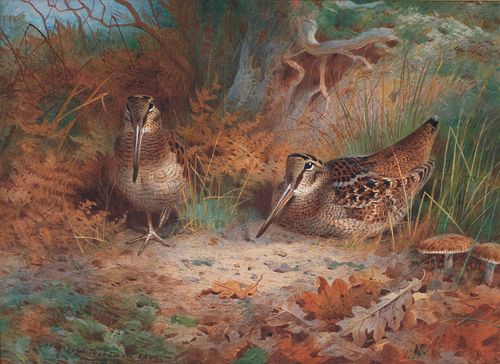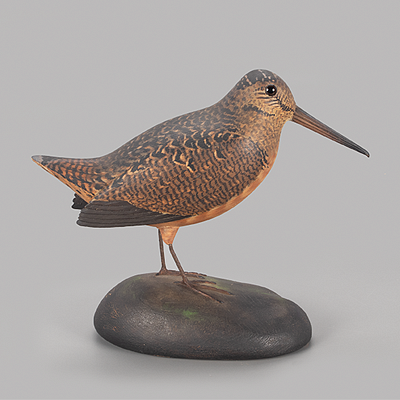Archibald Thorburn (British, 1860-1935), Woodcock
Lot 40
About Seller
Copley Fine Art Auctions
20 Winter Street
Pembroke, MA 02359
United States
Founded in 2005, Copley Fine Art Auctions is a boutique auction house specializing in antique decoys and American, sporting, and wildlife paintings. Over the course of the last two decades, the firm has set auction records for not only individual decoy makers, but also entire carving regions. Copley...Read more
Categories
Estimate:
$15,000 - $25,000
Absentee vs Live bid
Two ways to bid:
- Leave a max absentee bid and the platform will bid on your behalf up to your maximum bid during the live auction.
- Bid live during the auction and your bids will be submitted real-time to the auctioneer.
Bid Increments
| Price | Bid Increment |
|---|---|
| $0 | $50 |
| $1,000 | $100 |
| $2,500 | $250 |
| $5,000 | $500 |
| $10,000 | $1,000 |
| $25,000 | $2,500 |
| $50,000 | $5,000 |
About Auction
By Copley Fine Art Auctions
Jul 14, 2022
Set Reminder
2022-07-14 10:00:00
2022-07-14 10:00:00
America/New_York
Bidsquare
Bidsquare : The Sporting Sale 2022, Day 1
https://www.bidsquare.com/auctions/copley/the-sporting-sale-2022-day-1-9460
Lots 1-332 Copley Fine Art Auctions cinnie@copleyart.com
Lots 1-332 Copley Fine Art Auctions cinnie@copleyart.com
- Lot Description
Archibald Thorburn (British, 1860-1935)
Woodcock, 1909
signed and dated "Archibald Thorburn 1909" lower left
watercolor, 10 1/2 by 14 1/2 in.
titled on The Crossroads of Sport, New York label on back
"Reposing under an autumn sun, a pair of woodcock while away the warm serenity of a woodland glade. Amidst withering bracken and briar they take their ease at the edge of the birch covert, dozing yet alert and comforted by the presence of the fallen tree stump in whose depths one bird hides." — John Southern referring to "Woodcock Glade" in "Thorburn's Landscape," London, England, 1981, plate XLII
In 1887, Thorburn was commissioned by Lord Lilford to create hundreds of watercolors for Coloured Figures of the Birds of the British Isles. Throughout his career, he exhibited at the Royal Academy and select galleries in London. Thorburn was known for his lifelike scenes, derived from significant time in the field, observing and sketching birds in their natural habitats. An early conservationist, he was an active member and leader of the Royal Society for the Protection of Birds.
This charming depiction of two woodcock is a classic Thorburn, with one of the birds organically walking out of the lush browns and greens of the forest floor setting and a pair of mushrooms to balance the scene. The second bird crouches its stocky body on the ground. .
This vibrant Thorburn watercolor relates very closely in size, color, and composition to one of the artist's most famous works, titled "Woodcock Glade," which was made into a limited-edition print published by Embleton in 1923. An interesting side note, the Cocker Spaniel derives its name from the woodcock, as it was bred to hunt the popular gamebird.
Provenance: Eddie Woodin Collection
Literature: Sotheby's London, "Works by Archibald Thorburn from the Thorburn Museum," 1993, p. 23, closely related work illustrated.Please email condition report requests to leah@copleyart.com. Any condition statement given is a courtesy to customers, Copley will not be held responsible for any errors or omissions. The absence of a condition statement does not imply that the lot is in perfect condition.Condition
- Shipping Info
-
Shipping info
Copley does not offer in-house packing or shipping. For clients who require shipping, please complete the Shipping Release Form and return it with your payment. The form includes a list of shippers we frequently work with.
-
- Buyer's Premium



 EUR
EUR CAD
CAD AUD
AUD GBP
GBP MXN
MXN HKD
HKD CNY
CNY MYR
MYR SEK
SEK SGD
SGD CHF
CHF THB
THB














